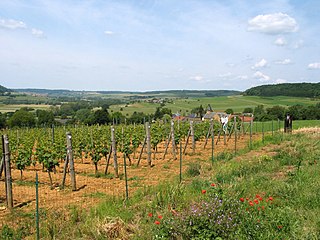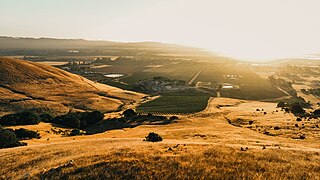Related Research Articles

Chardonnay is a green-skinned grape variety used in the production of white wine. The variety originated in the Burgundy wine region of eastern France, but is now grown wherever wine is produced, from England to New Zealand. For new and developing wine regions, growing Chardonnay is seen as a 'rite of passage' and an easy entry into the international wine market.

Champagne is a sparkling wine originated and produced in the Champagne wine region of France under the rules of the appellation, which demand specific vineyard practices, sourcing of grapes exclusively from designated places within it, specific grape-pressing methods and secondary fermentation of the wine in the bottle to cause carbonation.

Sparkling wine is a wine with significant levels of carbon dioxide in it, making it fizzy. While it is common to refer to this as champagne, European Union countries legally reserve that word for products exclusively produced in the Champagne region of France. Sparkling wine is usually either white or rosé, but there are examples of red sparkling wines such as the Italian Brachetto, Bonarda and Lambrusco, and the Australian sparkling Shiraz. The sweetness of sparkling wine can range from very dry brut styles to sweeter doux varieties.

Pinot noir is a red-wine grape variety of the species Vitis vinifera. The name may also refer to wines created predominantly from pinot noir grapes. The name is derived from the French words for pine and black. The word pine alludes to the grape variety having tightly clustered, pinecone–shaped bunches of fruit.

Pinot Meunier, pronounced[pi.nomø.nje], also known as Meunier or Schwarzriesling, is a variety of red wine grape most noted for being one of the three main varieties used in the production of Champagne. Until recently, producers in Champagne generally did not acknowledge Pinot Meunier, preferring to emphasise the use of the other noble varieties, but now Pinot Meunier is gaining recognition for the body and richness it contributes to Champagne. Pinot Meunier is approximately one-third of all the grapes planted in Champagne. It is a chimeric mutation of Pinot: its inner cell layers are composed of a Pinot genotype which is close to Pinot noir or Pinot gris; the outer, epidermal, layer is, however, made up of a mutant, distinctive, genotype. Pinot Meunier was first mentioned in the 16th century, and gets its name and synonyms from flour-like dusty white down on the underside of its leaves.

Louis Roederer is a producer of champagne based in Reims, France. Founded in 1776, the business was inherited and renamed by Louis Roederer in 1833. It remains as one of the few independent and family-run maisons de champagne. Over 3.5 million bottles of Louis Roederer champagne are shipped each year to more than 100 countries.
Gosset, founded in 1584, is the oldest wine house in Champagne. In 1584, Pierre Gosset, alderman of Aÿ and wine-grower, made still, mostly red, wines from the grapes he harvested from his own vines. In those days, two wines vied for pride of place at the table to the Kings of France: the wine of Aÿ and, from some hundreds of leagues further South, the wine of Beaune. Then, in the 18th century the wine made in around Aÿ began to bubble and the Gosset family turned naturally to the production of champagne.

Bollinger is a French Champagne house, a producer of luxury sparkling wines from the Champagne region. They produce several labels of Champagne under the Bollinger name, including the vintage Vieilles Vignes Françaises, Grande Année and R.D. as well as the non-vintage Special Cuvée. Founded in 1829 in Aÿ by Hennequin de Villermont, Paul Renaudin and Jacques Bollinger, the house continues to be run by members of the Bollinger family. In Britain, Bollinger Champagnes are affectionately known as "Bolly".

Bien Nacido Vineyards is cool-climate vineyard on the central coast of California. Located midway up the Santa Maria Valley, it is known for growing Burgundian and Rhone varieties of wine grapes. Bien Nacido has the distinction of being one of the major viticultural nurseries in the state for certified, varietal budwood. Most of the vines were originally from stock grown by the University of California at Davis. While the average increase block in California is less than 10 acres (40,000 m2), Bien Nacido Vineyards has several hundred acres of certified Chardonnay, Pinot Noir, Merlot and a number of other varieties. Much of the Chardonnay planted in California in the last twenty years began as Bien Nacido Vineyards cuttings.

Armand de Brignac, known colloquially as Ace of Spades, is a French Champagne owned by Shawn "Jay-Z" Carter and LVMH. The brand is produced by Champagne Cattier and sold in opaque metallic bottles. The brand's first bottling, Armand de Brignac Brut Gold, is identifiable by its gold bottle with French pewter Ace of Spades labels.

Willamette Valley Vineyards is an American winery located in Turner, Oregon. Named after Oregon's Willamette Valley, the winery is the leading producer of Willamette Valley-appellated Pinot Noir in Oregon, and also produces Chardonnay and Pinot Gris. In 2016, the winery was the largest producer of Riesling wine in the Willamette Valley.

Piper-Heidsieck is a Champagne house founded by Florens-Louis Heidsieck on 16 July 1785 in Reims, France. Heidsieck joined with Piper in October 1839. In the late 1980s, Piper-Heidsieck became part of the Rémy Cointreau wine and spirits group. It was sold in 2011 to Européenne de Participation Industrielle, a privately owned holding company of French luxury brands.

Duval-Leroy is a Champagne producer based in Vertus, a village in the Côte des Blancs region of Champagne. The house, founded in 1859, produces both vintage and non-vintage cuvées as well as a line of organic wines. The house of Duval-Leroy is also known for its pioneering role in promoting a sustainable development model for its viticulture.

Belgian wine is produced in several parts of Belgium and production, although still modest at 1,400 hectoliters in 2004, has expanded in recent decades.

Squerryes Court is a late 17th-century manor house that stands just outside the town of Westerham in Kent. The house, which has been held by the same family for over 280 years, is surrounded by extensive gardens and parkland and is a grade I listed building.
Cava is a sparkling wine of Denominación de Origen (DO) status from Spain. It may be white (blanco) or rosé (rosado). The Macabeo, Parellada and Xarel·lo are the most popular and traditional grape varieties for producing cava. Chardonnay and Malvasia are also permitted. Authorized red grapes are Garnacha tinta, Monastrell, Trepat, and Pinot Noir. Only wines produced in the traditional method may be labelled "cava"; those produced by other processes may only be called "sparkling wines". About 95% of all cava is produced in the Penedès area in Catalonia, Spain, with the village of Sant Sadurní d'Anoia being home to many of the largest Catalan production houses. The two major producers are Codorníu and Freixenet. Cava is also produced in other villages in the provinces of Girona, Lleida, Tarragona, and Barcelona in Catalonia, Zaragoza in Aragon, Badajoz in Extremadura, La Rioja, Araba/Álava in the Basque Country, Navarra and València in the Valencian Community.

Gloria Ferrer Caves & Vineyards is a winery in Sonoma County, California that specializes in sparkling wines, as well as Pinot noir and Chardonnay wine. It was the first sparkling wine producer in Carneros. It was also the first to plant Champagne grape clones in the region.

Sussex wine is wine produced in the historic county of Sussex in southern England, a region divided for administrative purposes into East Sussex and West Sussex. In 2022, Sussex wine gained Protected Designation of Origin status in the European Union's Geographic Indication scheme. This followed the granting of protected regional status by the Department for Environment, Food and Rural Affairs (DEFRA) in 2016.
Gruet Winery is a New Mexico winery and family business founded in 1984. It specializes in Methode Champenoise sparkling wines using Pinot Noir and Chardonnay grapes, and also produces some still wine. It traces its history to Gilbert Gruet's Champagne house, Gruet e Fils, which he established in 1952 in Bethon, France. After a visit to New Mexico in 1983 and meeting with a group of European vinters who had successfully planted vineyards there, Natalie and Laurent Gruet planted an experimental vineyard of Chardonnay and Pinot Noir in Engle, New Mexico about 10 miles from Truth or Consequences. The first release was in 1989, principally sparkling wine. In 1993, Gruet opened its own winery and tasting room in Albuquerque.

English sparkling wine is sparkling wine from England, typically produced to the traditional method and mostly using the same varieties of grapes as used in Champagne – Chardonnay, Pinot noir and Pinot Meunier. English sparkling wine producers often employ Champagne terminology to describe the styles of their wine, such as "Classic Cuvée", "Blanc de Blancs" or "Demi-Sec".
References
- 1 2 "About Squerryes | The Squerryes Estate". squerryes.co.uk. Retrieved 11 July 2016.
- ↑ Wells, Andrew (2008). "Squerryes." Informational pamphlet.
- 1 2 "Sparkling Wine | The Squerryes Estate". squerryes.co.uk. Retrieved 11 July 2016.
- 1 2 "Charmans Press Release" (PDF). Westerham Brewery.
- ↑ "Squerryes Celebration 20th / 21st June – a long time coming!" . Retrieved 11 July 2016.
- ↑ "UK's only on-trade wine competition – the Sommelier Wine Awards | Sommelier Wine Awards". www.sommelierwineawards.com. Retrieved 11 July 2016.
- ↑ Media, William Reed Business. "International Wine Challenge - The most influential wine competition in the World". www.internationalwinechallenge.com. Retrieved 11 July 2016.
{{cite web}}:|first=has generic name (help) - ↑ "Plans revealed for Westerham Brewery's proposed homecoming". 26 February 2014. Retrieved 11 July 2016.